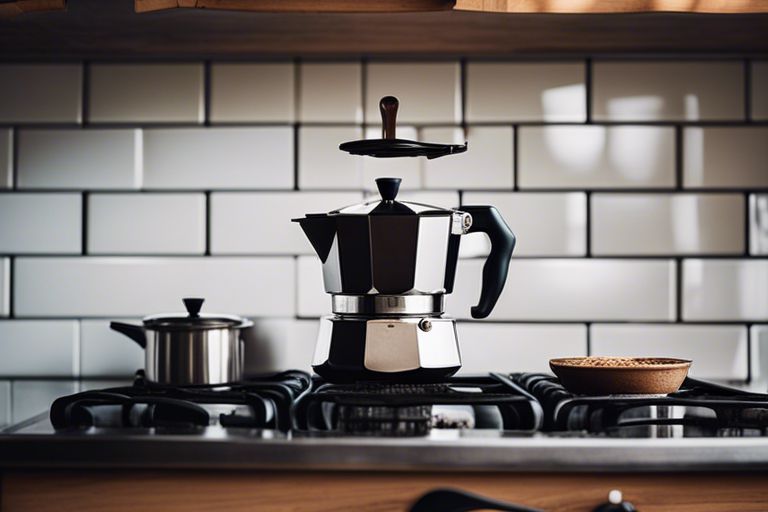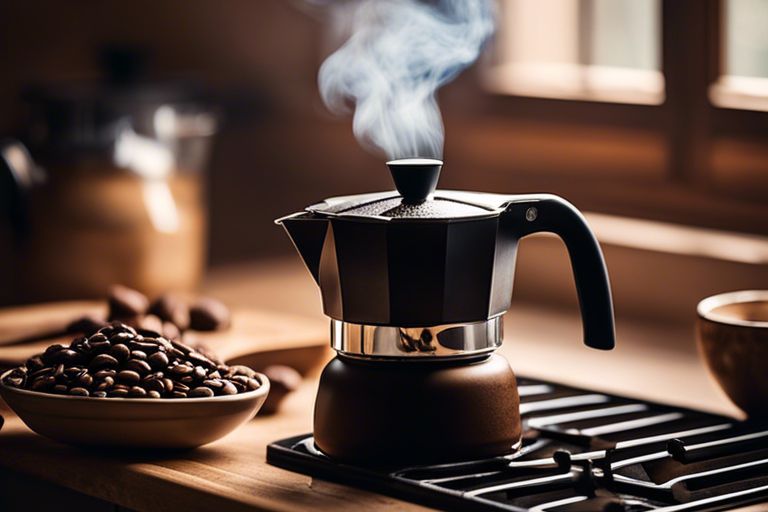It’s time to demystify the humble Moka pot – a classic coffee maker cherished by espresso lovers worldwide. The Moka pot, also known as a stovetop coffee maker, is a simple yet ingenious device designed to brew a strong and flavorful coffee that rivals the taste of espresso. This article will explore into the history, construction, and brewing process of the iconic Moka pot, allowing you to brew your perfect cup of stovetop coffee with ease. So, grab your favorite coffee beans and let’s explore the world of the Moka pot.
Key Takeaways:
- Moka pot: A stovetop coffee maker that brews coffee by passing boiling water pressurized by steam through ground coffee.
- Design: Consists of lower chamber for water, middle chamber for ground coffee, and upper chamber for final brewed coffee.
- History: Invented in 1933 by Alfonso Bialetti and remains a popular choice for coffee enthusiasts seeking a strong, espresso-like brew at home.
Origins
The Moka Pot Is an Inexpensive Espresso Alternative that has found its way into many kitchens worldwide. This iconic stovetop coffee maker has a rich history and interesting origins that have contributed to its enduring popularity.
History of the Moka pot
Origins of the Moka pot date back to the early 1930s in Italy. Created by engineer Alfonso Bialetti, the Moka pot was designed as a simple, affordable, and efficient way to brew coffee that resembled espresso. Its distinctive octagonal shape and aluminum construction quickly made it a staple in Italian households and later, in kitchens around the globe.
Inventor and patent information
With its invention credited to Alfonso Bialetti, the Moka pot gained popularity after he acquired a patent for the design in 1933. Fueled by Bialetti’s innovative spirit and a desire to create a coffee maker that was accessible to the masses, the Moka pot soon became a household crucial in Italy and beyond.
Understanding the origins and the creative mind behind the Moka pot adds a layer of appreciation for this humble yet effective coffee maker that has stood the test of time.

Design and Functionality
Unique stovetop brewing system
To truly understand the design and functionality of a Moka pot, you need to grasp its unique stovetop brewing system. This system is what sets the Moka pot apart from other coffee makers. It works by using steam pressure to push hot water through coffee grounds, resulting in a strong and flavorful espresso-like brew.
Materials used in construction
Design plays a crucial role in the functionality of a Moka pot, especially concerning the materials used in its construction. Typically made of stainless steel or aluminum, these materials are chosen for their durability and heat-conducting properties. Stainless steel models are favored for their modern aesthetic and longevity, while aluminum ones are known for their excellent heat distribution.
Plus, some Moka pots feature ergonomic handles and knobs that stay cool to the touch, making them safe and easy to handle even when brewing piping hot coffee.
Heat distribution and pressure control
An vital aspect of a Moka pot’s design is its ability to evenly distribute heat and control pressure during the brewing process. This ensures that the coffee grounds are extracted efficiently, resulting in a rich and aromatic coffee with a velvety crema on top. Additionally, the pressure control mechanism helps prevent the coffee from boiling or burning, maintaining the perfect brewing temperature.
Understanding the science behind these key design elements can enhance your appreciation for the art of brewing coffee with a Moka pot.
How it Works
Now, let’s examine how a Moka pot works to brew that perfect cup of coffee. The Moka pot operates on a simple yet effective process that relies on water pressure to brew a strong, aromatic coffee often likened to espresso.
Step-by-step brewing process
| Step 1 | Fill the bottom chamber with water up to the safety valve. |
| Step 2 | Insert the filter basket and fill it with finely ground coffee. |
| Step 3 | Screw on the top chamber securely. |
| Step 4 | Place the Moka pot on the stove and heat until the coffee starts to gurgle up into the top chamber. |
| Step 5 | Once the top chamber is full of coffee, remove from heat and pour into your cup. |
Science behind the Moka pot’s operation
processThe Moka pot works based on a simple yet effective principle of water vapor pressure building up in the bottom chamber due to the heat from the stove. This pressure pushes hot water up through the coffee grounds in the filter basket and into the top chamber, creating a strong coffee concentrate.
Stepbystep This process is similar to how espresso is made, but with lower pressure and a gentler extraction. The result is a flavorful and intense coffee that is richer than drip coffee but less concentrated than espresso.
Tips for optimal use
- Use freshly ground coffee for the best flavor.
- Grind the coffee to a fine consistency, similar to table salt.
- Avoid packing the coffee too tightly in the filter basket to allow for proper water flow.
Works Knowing these tips can help you master the art of brewing coffee with a Moka pot and enjoy a delicious cup every time.
To wrap up, understanding how a Moka pot works and the science behind its operation can enhance your coffee-making experience and help you appreciate the unique brewing method it offers. By following the step-by-step process and implementing tips for optimal use, you can brew a flavorful cup of coffee that rivals your favorite café.

Benefits
Rich flavor and aroma
To experience a rich and full-bodied flavor in your coffee, the Moka pot is a must-have in your kitchen arsenal. Its brewing process allows the water to extract the coffee grounds’ oils, resulting in a robust and aromatic cup of coffee that rivals any espresso.
Cost-effective and eco-friendly
Cost-effective and eco-friendly, the Moka pot offers a budget-friendly way to enjoy quality coffee without the need for expensive machines or single-use pods. With its durable design and reusable components, it’s a sustainable choice for coffee lovers looking to reduce their environmental footprint.
In addition to being environmentally conscious, the Moka pot is also a cost-effective option for long-term use. While espresso machines can be costly to purchase and maintain, a Moka pot is an affordable initial investment that requires minimal upkeep, making it a practical choice for those mindful of their budget.
Versatility in brewing options
Ecologically sound in its design, the Moka pot offers versatility in brewing options, allowing you to experiment with different coffee blends, grind sizes, and brewing techniques. Whether you prefer a strong espresso-like shot or a milder coffee, the Moka pot can cater to your taste preferences with ease.
With its ability to brew various styles of coffee, the Moka pot is a versatile tool that can adapt to your changing coffee cravings. Whether you enjoy a quick morning espresso or a leisurely afternoon coffee, the Moka pot provides the flexibility to customize your brew to suit your mood.
Types of Moka pots
Despite its simple design, the Moka pot comes in various types that cater to different preferences and needs. When choosing a Moka pot, it is imperative to consider the material, size, and whether you prefer an electric or stovetop model. Knowing the differences between these types can help you find the perfect Moka pot for your brewing routine.
Aluminum vs. stainless steel vs. copper
One significant factor to consider when selecting a Moka pot is the material it is made of. The most common materials used in Moka pots are aluminum, stainless steel, and copper. Each material has its benefits and drawbacks, ranging from heat conductivity to durability.
| Aluminum | Stainless Steel |
| Lightweight | Durable |
| Affordable | Resistant to rust |
| Excellent heat conduction | Modern look |
| Can impart a slight metallic taste | More expensive |
| Not suitable for induction stoves | Heavier than aluminum |
In terms of choosing between aluminum, stainless steel, and copper Moka pots, it ultimately boils down to personal preference and brewing habits.
Size variations and capacity
Aluminum Moka pots are the traditional choice and are favored by purists for their ability to enhance the flavors of the coffee. They are also lightweight and affordable, making them a popular option for beginners or those on a budget.
When selecting a Moka pot, consider the size variations and capacity that best suit your coffee consumption habits. Moka pots typically range from 1-cup to 12-cup capacities, allowing you to brew a single serving or make coffee for a group of friends.
Electric and stovetop models
An electric Moka pot is a convenient option for those who prefer a hands-off brewing experience. These models often come with automated features like timers and keep warm functions, perfect for busy mornings when you need a quick caffeine fix.
When choosing between electric and stovetop models, consider your brewing preferences and lifestyle to find the Moka pot that best fits your needs.
Maintenance and Care
Cleaning and Descaling
Cleaning your Moka pot regularly is necessary to maintain its performance and flavor. Rinse the pot with warm water after each use and avoid using soap, as it can leave a residue that affects the taste of your coffee. To deep clean, disassemble the Moka pot and scrub it with a brush to remove any coffee oils or residues. Descaling is necessary to prevent mineral buildup, which can affect the brewing process. Use a descaling solution or a mixture of water and vinegar to clean the inside of the pot thoroughly.
Storage and Handling Tips
- Store your Moka pot in a dry place to prevent rust and corrosion.
- Avoid using abrasive cleaners that can damage the pot’s surface.
With proper care, your Moka pot can last for years and continue to brew delicious coffee. Make sure to dry the pot completely before storing it to prevent mold growth. Assume that any leftover coffee grounds can also affect the taste of your next brew.
Troubleshooting Common Issues
Care for your Moka pot by troubleshooting common issues that may arise. If your coffee tastes bitter, try using a coarser grind to prevent over-extraction. If the brewed coffee has a metallic taste, it could indicate mineral buildup, requiring a thorough descaling. Understanding how to address these issues will help you enjoy a consistently great cup of coffee from your Moka pot.

To wrap up
Upon reflecting on the article “What is a Moka pot”, it becomes evident that this brewing device has a rich history and a unique method of extracting coffee. Its simplicity in design and efficiency in producing a strong and flavorful coffee make it a popular choice among coffee enthusiasts. While modern coffee makers offer various features and brewing methods, the Moka pot remains a classic and timeless piece that continues to hold its place in many kitchens around the world.
FAQ
Q: What is a Moka pot?
A: A Moka pot is a stovetop coffee maker that brews coffee by passing boiling water pressurized by steam through ground coffee.
Q: How does a Moka pot work?
A: A Moka pot works by filling the bottom chamber with water, adding ground coffee to a filter basket, assembling the pot, and heating it on a stovetop until the water boils and coffee is brewed into the upper chamber.
Q: What type of coffee does a Moka pot produce?
A: A Moka pot produces a strong and concentrated coffee similar to espresso, but with a different flavor profile due to the brewing process.
Q: Is it easy to use a Moka pot?
A: Yes, using a Moka pot is relatively easy once you get the hang of it. It requires a bit of practice to achieve the perfect brew, but it’s a simple and satisfying way to make coffee at home.
Q: How do you clean a Moka pot?
A: To clean a Moka pot, disassemble it after each use, wash the parts with warm water and mild detergent, and make sure to dry it thoroughly to prevent rust. Avoid using soap or putting it in the dishwasher to maintain the flavor of your coffee.
What are the best coffee regions in the world





